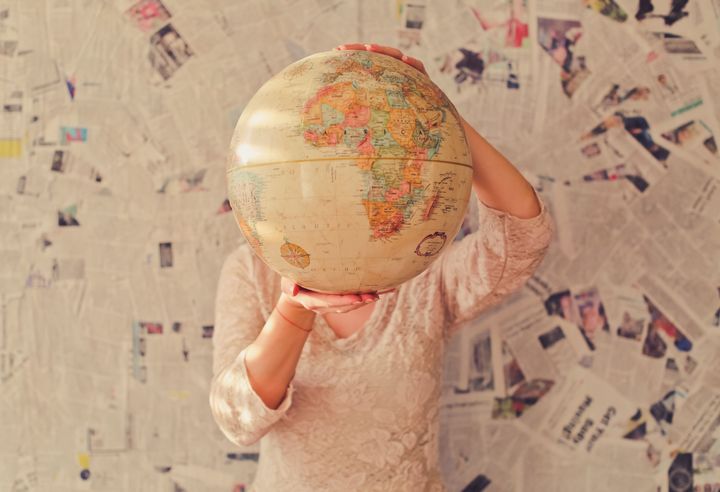
2017 was pretty exhausting. Being a mum to two tiny humans means feeling tired is par for the course, but the past year has left me feeling worn out on a whole new level. There were days when the onslaught of bad news headlines felt relentless and I often found myself wanting to hide from it all, curl up under a duvet and binge on Netflix. I was having one of these days a couple of weeks ago and in the absence of my duvet and popular internet streaming service, I chose instead to indulge in some mindless newsfeed-scrolling, vaguely hoping to stumble upon something more lighthearted. Nestled in amongst the pictures of other people’s children dressed in festive novelty outfits I came across this quote by Arundhati Roy:
“Another world is not only possible, she is on her way.
On a quiet day, I can hear her breathing.”
It reminded me to stop. Breathe. Pay attention. If you look behind the headlines of all the tragic events that have filled our screens this year, you’ll find stories pointing towards hope: the emergency workers that worked for hours to save lives after a terrorist attack and members of the public who helped tend to the wounded; the men who protected strangers from an unprovoked anti-Muslim attack; the courageous women speaking up against a decades-old system of sexism and abuse.
Yep, the world may have gone mad. We may have natural disasters wreaking havoc and a US President who apparently spends most of his time on Twitter (Sad!). But pay attention and you’ll spot those glimmers of hope: the stories of people who haven’t forgotten what it means to be human — those who look beyond race, gender, religion and politics and recognise the humanity that connects us to each other. These are the stories that keep me going and remind me that the things I choose to say and do make a difference.
Each morning when I get dressed I’m reminded of an image that’s been imprinted on my mind ever since I saw it. It’s a picture of a pair of jeans, half buried in rubble and covered in dust, the label of a high street store poking up through the debris. In the late morning of 24 April 2013, the Rana Plaza building in Dhaka, Bangladesh collapsed. Inside it were thousands of people who worked for different clothing factories housed within the building; workers who didn’t want to be there that day. Earlier that morning they’d gathered outside, afraid to enter after huge cracks had been discovered in the pillars supporting the building the day before. They finally relented after management threatened to withhold their wages. Moments after work began the lights went out, a loud crack resounded through the air and the building came crashing down, killing more than one thousand people and severely injuring over twice as many.
Those jeans were meant to end up in a shop somewhere on the other side of the world, sold for a bargain price and added to a wardrobe probably already bursting with too many other pairs of jeans. Instead, they ended up buried under broken lumps of concrete and the broken bodies of the people who moments earlier had been sat at their sewing machines, heads down, eyes focused on the stitches joining pieces of fabric together, under pressure to meet a deadline.
That image was one of the things that kickstarted my journey into the inner workings of the fashion industry. The things I’ve discovered since then have angered me and broken my heart in equal measure. Fashion is a multi-billion dollar industry; it employs 1 in 6 people worldwide and produces billions of garments each year. Yet while sales of clothing continue to bring in mighty profits for high street brands, many of the people who make those clothes don’t receive a living wage. Workers routinely experience verbal, physical and sexual harassment and often have to work in dangerous conditions. Water sources are being polluted and landfills are overflowing.
When it comes to budget brands selling clothes at insanely low prices it’s not a giant leap to see that someone, somewhere along the line isn’t getting a fair deal. But these issues are not isolated to discount stores; they’re prevalent right the way through popular high street names all the way up to luxury brands. The problems seem so ingrained and the industry is so huge that it’s easy to feel overwhelmed. I’ve often wondered whether I could ever really do anything to change it; I’m only one person, right?
Right. But here’s the thing:
One person, plus another person, plus another, plus another…
Equals power. Equals a trickle turning into a flood. Equals a whisper turning into a roar; a collective voice getting louder. Equals a living, breathing, growing movement leaving stories of change in its wake.
Together Street is for anyone who thinks that the clothes we wear shouldn’t exploit the earth or the people who make them. It’s a place to learn from each other about the small steps we can take to change our shopping habits, celebrate the people turning fashion into a force for good, discover new brands who are doing things differently and encourage high street brands to do better. Throughout 2018 we’ll be posting challenges to help you think and provide inspiration for all the different ways you can add your voice to the growing movement calling for change.
This year I want my clothes to tell a different story.
Let’s do it together.
— — — — — — — — — — — — — — — — — — — — — — — — — — — — — — —
Together Street launches on 12 January 2018. Until then, sign up for updates and follow the action on Instagram, Twitter and Facebook.
